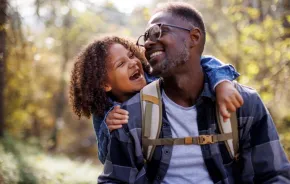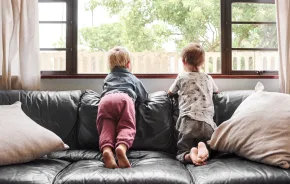
Amid a growing number of headlines about sexual assault, one word keeps popping up: Consent. From the #MeToo movement to Aziz Ansari, we find ourselves asking, “How do we raise kids who get it?”
It’s natural to want to delay having a conversation with your child about consent, let alone about sexual assault, abuse or rape. These are difficult topics from which we’d prefer to shield our kids. But when a third of male college students don’t know what “rape” means and 35 percent of those who’ve experienced sexual assault are “unclear that it was a crime or that harm was intended,” it’s obvious that the standard rubric for “The Talk” needs to change.
One of the best ways to shift the conversation is to have it — frequently and as early as possible.
“As a psychotherapist who works with many survivors of sexual assault, I see consent education as abuse prevention,” explains Rhea St. Julien, a San Francisco-based psychotherapist and mother of a 7-year-old. She started teaching consent with her daughter early. “A child who really understands that their body is their own will be less of a target for predators. There's little I can do to protect [my daughter] from abuse out in the world, but the more I empower her in her own body, the more internal safety she will feel.”
Consent means so much more than verbally telling someone that you want to have sex. It’s about believing that you as a person have the power to choose whether or not to engage in physical affection or touching, no matter how innocent it is — and to be assertive about what happens with your body. If we’re born with that power, the world certainly tries its best to knock that power away from us. So we need to learn it.
But what does consent look like at every age? And how do you start teaching it and keep at it so your child not only understands it, but appreciates and respects it in others, too? We spoke with experts and parents about how they instill this important lesson.
Strategy No. 1: It’s Okay to Say ‘No’
St. Julien has made it a point to teach her daughter how to express herself when she doesn’t want to be touched. “When she tells me about a boy at school tackling her or hugging her without asking, I suggest she tell them, ‘No, thank you! Please ask next time,’” she says. “We also work hard on what to say when people touch her Afro without her consent. ‘Please don’t touch my hair!’ is the usual reply.”
Even as his mother, I try to always ask [my son] before I give him a hug or a kiss.
Kids, especially babies, often receive attention from strangers without being asked for any sort of permission. “It’s as if they're objects, not humans,” says Brittney Bollay, a Seattle mother to a 5-year-old. To counteract that objectification, Bollay decided to teach her son as soon as possible that “his body was his and he was in charge of it.” That means she never requires him to hug or kiss relatives — including herself. “Even as his mother, I try to always ask him before I give him a hug or a kiss.”
Of course, giving kids more control over their own bodies doesn’t mean tickle time is off-limits — it just changes. In St. Julien’s case, tickling has an extra playful twist. “I taught [my daughter] a ‘spell’ she can perform to stop the tickling,” she says. “When she does the spell, I can’t tickle her anymore — my hands don't work! She loves the empowerment she feels when I show her that the spell worked by flopping my hands around.”
That spell? It’s saying the word “no.”
Strategy No. 2: When They’re Young, Give Them Options
Of course, you don’t want to raise a kid who shuns all attention. Rather, you want them to understand their own boundaries and be empathic to others’. An easy way to teach that: Give your kid options. “I think it’s important social learning to greet and say goodbye to other people,” St. Julien explains. “So, I offer, ‘Do you want to wave, fist bump, high-five or hug?’”
You might like these, too
We talk to sex therapist Jo Langford about how to teach boys consent and hear from a mother on how sexual assault influences how she raises her daughter.
Little kids can’t always have full bodily autonomy — they need baths, they need to get to the doctor, they sometimes need their hand held while crossing the street. “In those cases, we try to at least treat them respectfully and explain why we are doing what we are doing, instead of just because I said so,” says Seattle parent Astrid Gielen, who has a 2-year-old and a 6-year-old. “And we talk about it a lot.”
It can be especially hard when a parent has to take control — like when a kid has a temper tantrum in a grocery store. “[Take] deep breaths, stay calm and don’t make eye contact with other people or you’ll lose your cool,” says Gielen. “I just keep repeating, loudly, in as calm a voice as possible, stuff like ‘I’m sorry. You are not in control of your body right now and it’s my job to keep you safe. I need to hold your hand to keep you safe here in line with me. If you can calm down and stand in line nicely, we don’t have to hold hands.’”
Granted, that isn’t exactly easy, Gielen says. “You feel like everyone on the planet is staring at you, but the only way out is through,” she says.
Strategy No. 3: Don’t Keep It to the Kids
For some, it’s not their kids who are the hard part about teaching consent. It’s the rest of the family. “Frankly, talking to [my 4-year-old] about consent is the easy part,” says Carla Chavez of Seattle. “He gets it as much as a toddler can. But dealing with grown-ups who don’t is the hard part.”
Chavez says she has to stand up for him and “show that it’s okay to be uncomfortable and say ‘no’ ... it’s an educational process for my relatives as well as the kid.”
Stefanie Le Jeunesse, a mother of three in Mount Vernon, guides touchy relatives “toward something more meaningful than a tickle fight.”
Her method is similar to introducing two people at a party: She sets them up to talk about shared interests. For example: “This is Jane. She loves horses. And this is Zelda. She’s been wishing for horse riding lessons. Right, Zelda? Do you want to tell Jane about that?” or “George, did you know that Sarah is an engineer? Would you like to tell her about your robotics class?”
This applies to older kids, too. By being vocal about your own boundaries as an adult, you provide a role model for what consent looks like, and kids can pick up on those skills to advocate for themselves and treat others with respect. Don’t shy away from addressing specific situations. Whether you see them on TV or in real life, they can be examples of what consent should or shouldn’t look like.
Strategy No. 4: Keep the Conversation Going
The idea with consent education is that eventually, kids learn to develop boundaries — and respect other people’s boundaries, too. “As they get a little older, we can start talking about how this applies to other people” says Gielen.
For Gielen, that means providing her 6-year-old very specific praise when, say, he respects that Mom asked for a little space. And when he doesn’t give her that space? “I try to use the same language of, ‘This is my body and I don’t want to be touched right now and you need to respect that.’”
Sometimes I feel like we're having these conversations a lot, but it’s important.
Bollay has started having conversations with her 5-year-old about how consent isn’t a one-way street.
“As [my son has] gotten older, we’ve had more conversations about how these same rules also go the other way,” Bollay says. One example: She’s explained to her son that if anyone asks him to stop touching them, he needs to immediately stop. That’s a hard lesson — “he’s very snuggly” — but repetition is key. “Sometimes I feel like we're having these conversations a lot, but it’s important.”
Repetition also means keeping the conversation going into their tween and teen years. Seattle dad Forrest Baum has found that helping his 2-year-old son set boundaries has also been a valuable teaching moment for his 12-year-old. His family has been implementing many of the same strategies as other parents, like asking if he wants to hug Grandma.
“I think having [my 12-year-old] witness this process was great ‘cause now he’s in middle school and I hadn’t thought about it in awhile, other than knowing it’s an important time to talk more,” says Baum. “Coming back to it seems so important, especially as he’s growing up.”
Scaling the conversation as kids get older takes a similar approach to laying the groundwork. Adapt lessons about consent to what kids are experiencing in their everyday lives, whether it’s hugging or accepting an invitation to a concert.
The Unitarian Universalist Association’s Our Whole Lives (OWL) curriculum has various levels of holistic sexuality education tailored to age groups from kindergarten to adulthood. Adam House teaches OWL to seventh- and eighth-graders in his congregation at a level which includes role-playing scenarios like a friend asking another friend to ditch school for a hockey game.
The exercises aim to help kids be confident in their decisions and gracious in accepting others’. OWL also includes some practical exercises similar to the ones used on little kids.
“We practice asking one another ‘Can I give you a high-five?’ as a low-stakes introduction to asking consent for physical contact,” House says. “We also use ice cream as a metaphor: Sometimes you want ice cream and will accept it if it’s offered, but sometimes you don’t want it. Just because you accepted ice cream from someone yesterday doesn’t mean they should scoop you up a bowl every time you’re at their house, and certainly doesn’t mean you’re obligated to eat said bowl.”
Students also practice how to spot a real “yes” and accept a “no,” whether it’s obvious or more subtle. “We practice both responses with a variety of different phrases,” House says. “Then we talk about which of those were real consent, which were clearly not consent and which were ambiguous.”
Such exercises help teach kids the concept of “enthusiastic consent,” or making sure someone is as excited and into someone else’s enjoyment as you are excited and into your personal enjoyment. It’s an important step in making sure kids grow into adults who can recognize and give consent in all elements of their lives, not just sex.
“Anything that seems like a gray-area response, or a non-response, really isn’t consent,” House says. That — accepting yesses and nos out of care for the other person, not on technicalities — gets to the heart of what it means to fundamentally understand consent. This is how we can raise our kids to lead a cultural shift where bodies are valued and respected.











